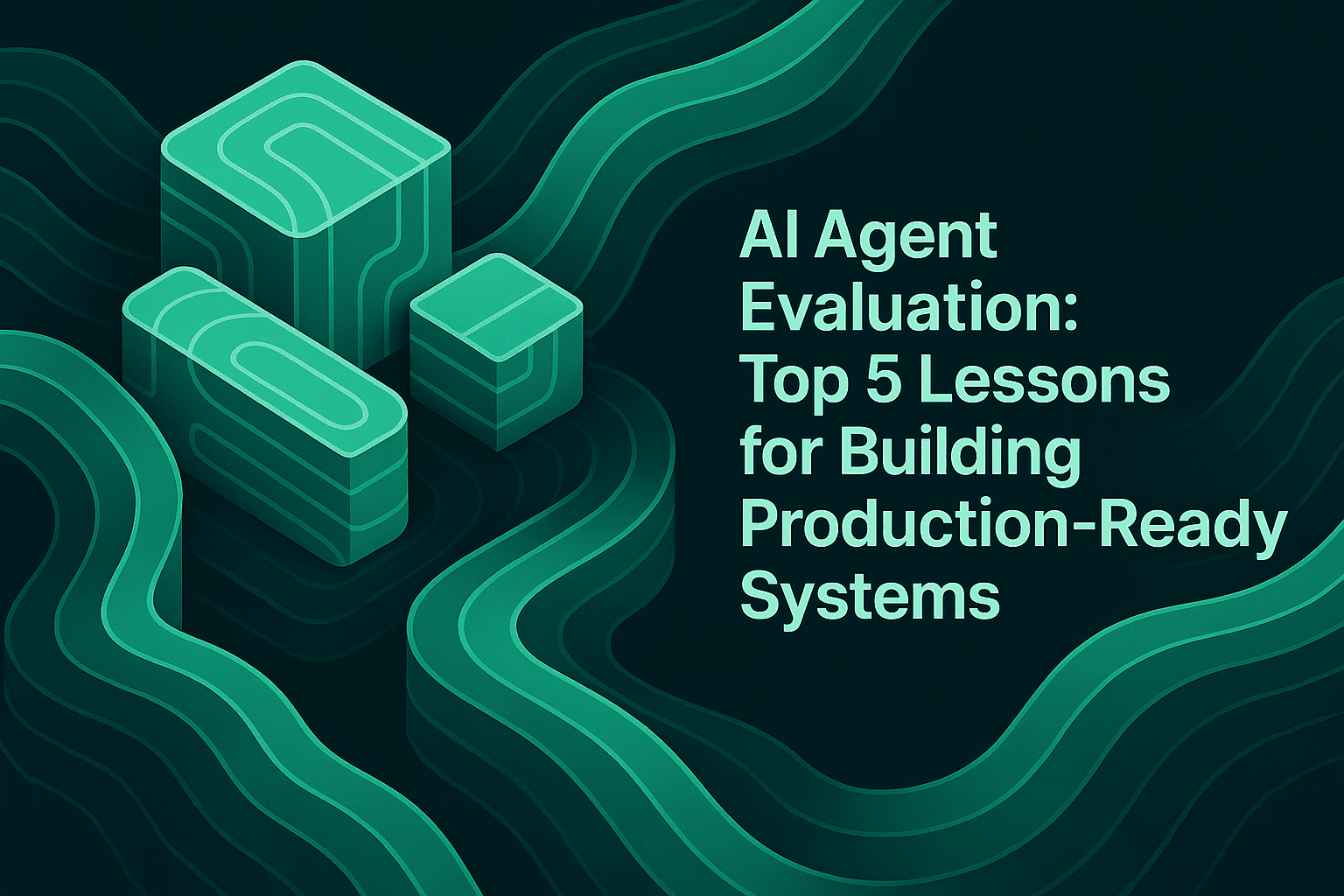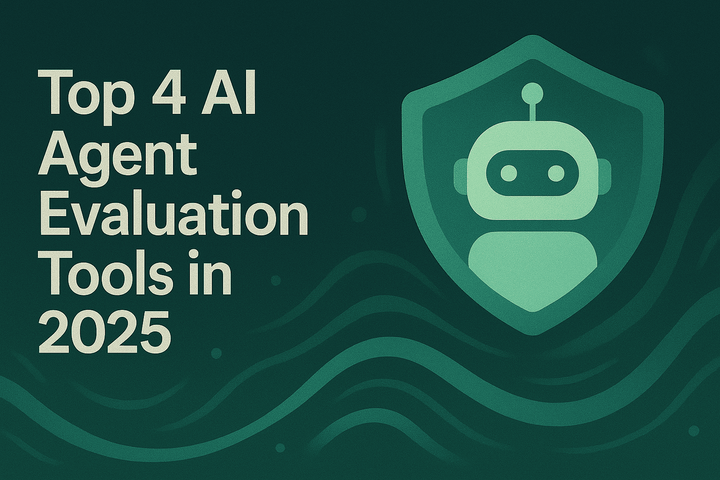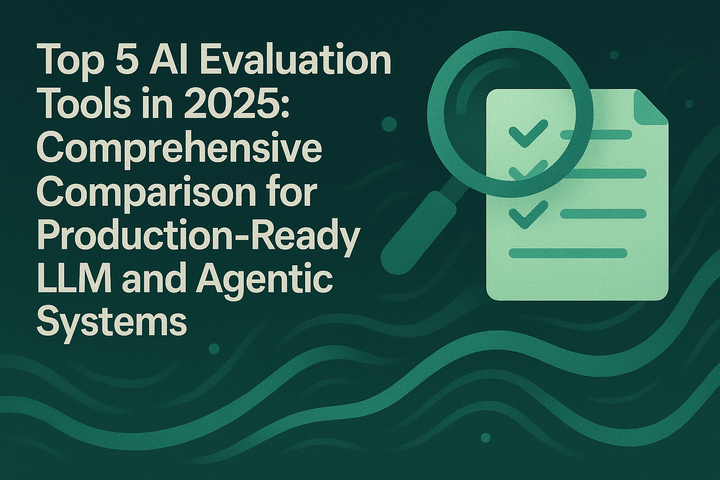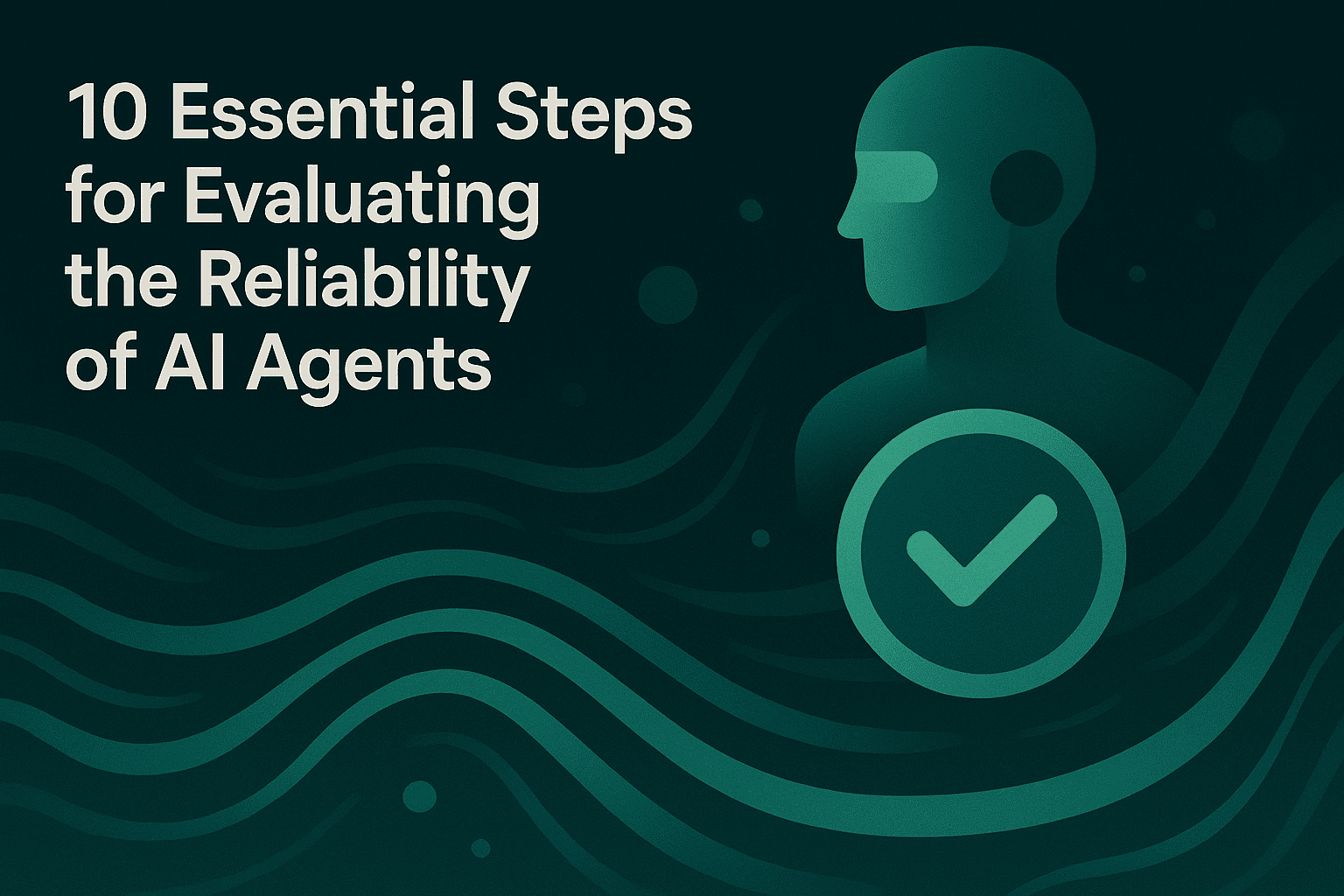AI Agent Evaluation: Top 5 Lessons for Building Production-Ready Systems

TL;DR
Evaluating AI agents requires a systematic approach that goes beyond traditional software testing. Organizations deploying autonomous AI systems must implement evaluation-driven development practices, establish multi-dimensional metrics across accuracy, efficiency, and safety, create robust testing datasets with edge cases, balance automated evaluation with human oversight, and integrate continuous monitoring into production workflows. Teams that adopt these practices can ship reliable AI agents faster while maintaining quality standards. Maxim AI provides an end-to-end platform combining experimentation, simulation, and observability to help engineering and product teams measure and improve AI agent quality throughout the development lifecycle.
Lesson 1: Evaluation-Driven Development Prevents Costly Production Failures
AI agent development fundamentally differs from traditional software engineering. Unlike deterministic code where inputs consistently produce expected outputs, agents powered by large language models operate in non-deterministic ways. This unpredictability demands a new development philosophy centered on continuous evaluation.
Organizations cannot rely on unit and integration testing alone when building AI agents. Traditional software testing validates whether code executes as written, but AI agent evaluation must assess whether autonomous systems make appropriate decisions across diverse scenarios. Research from UC Berkeley's California Management Review highlights that as AI agents gain more autonomy, the need for rigorous evaluation intensifies to ensure safe and proper functioning.
Evaluation-driven development shifts quality assurance from an afterthought to a foundational practice. Instead of building complete agent systems and testing them later, teams embed evaluation into every development stage. This approach enables rapid iteration by providing quantitative feedback on whether changes improve or degrade agent performance.
Maxim's experimentation platform supports this workflow through Playground++, which enables prompt engineering teams to iterate, deploy, and experiment with agent configurations. Engineering teams can organize and version prompts directly from the UI, deploy with different variables, and compare output quality, cost, and latency across various combinations without code changes.
The principle of "shift left" in AI development parallels software engineering best practices. By identifying issues during development rather than after deployment, organizations prevent knowledge gaps, inconsistent responses, and vulnerabilities from reaching production. Recent industry analysis shows this proactive approach has become standard practice, supported by well-defined testing suites and specialized monitoring platforms.
When building AI agents, teams should establish baseline performance metrics before making architectural changes. This practice transforms optimization from guesswork into data-driven decision making. Teams can compare prompt variations, model selections, and reasoning strategies based on measurable outcomes rather than subjective impressions.
Lesson 2: Multi-Dimensional Metrics Reveal True Agent Performance
Optimizing for a single metric creates blind spots that compromise overall agent quality. Comprehensive evaluation must consider accuracy, latency, cost, customer satisfaction, and safety simultaneously. Research from Sendbird emphasizes that evaluation frameworks should assess multiple dimensions to ensure agents do the right things effectively and reliably.
Accuracy and Task Completion
Accuracy measures how closely agent outputs match intended results. For multi-step tasks, evaluation must assess whether agents successfully complete entire workflows, not just individual steps. Task completion rates indicate whether agents achieve their goals in real-world scenarios.
Maxim's evaluation framework enables teams to measure quality quantitatively using AI, programmatic, or statistical evaluators. The platform's evaluator store provides off-the-shelf evaluators while supporting custom evaluators suited to specific application needs. Teams can visualize evaluation runs on large test suites across multiple versions to identify improvements or regressions.
Efficiency and Resource Utilization
Technical metrics alone do not guarantee business value. An AI agent that provides accurate responses but takes excessive time or consumes costly computational resources may fail to deliver positive ROI. Efficiency evaluation tracks response time, API usage, and infrastructure costs.
Studies show that two agents with similar accuracy may have significantly different operational costs at scale. Balancing accuracy with efficiency ensures sustainable agent deployment. Teams should monitor compute costs and resource utilization alongside quality metrics to make informed tradeoffs.
Robustness Under Stress
Production environments generate unexpected queries, ambiguous inputs, and edge cases. Robustness testing examines how agents behave under stress conditions, including malformed prompts and adversarial examples. This evaluation dimension proves especially critical for user-facing applications where unusual queries represent the norm rather than exceptions.
Agent evaluation platforms should test how systems maintain coherence across multiple conversation turns, handle context switching, and recover from errors. Research from Microsoft and Salesforce demonstrates that custom evaluations tailored to specific use cases outperform generic pass-fail metrics by assessing compliance with guidelines, response latency, and domain-specific requirements.
Safety and Alignment
As AI agents gain autonomy, safety evaluation becomes non-negotiable. Agents must avoid harmful behaviors, respect ethical boundaries, and maintain alignment with organizational values. Evaluation frameworks should assess whether agents refuse inappropriate requests, respect privacy, and escalate high-risk decisions appropriately.
Industry research emphasizes that robust evaluation practices transform agentic AI pilots into reliable production systems that deliver lasting value. Safety metrics should track hallucination rates, bias indicators, and compliance with regulatory requirements.
Lesson 3: Representative Test Data Determines Evaluation Quality
Evaluation frameworks prove only as effective as the datasets used for testing. Building comprehensive test suites requires strategic data collection, careful curation, and continuous evolution based on production insights.
Dataset Construction Best Practices
Organizations should maintain at least 30 evaluation cases per agent, according to industry best practices from UiPath. Test datasets must include success cases that validate core functionality, edge cases that explore boundary conditions, and failure scenarios that verify error handling.
Representative test data reflects the distribution of real-world inputs agents will encounter in production. Teams should analyze historical user interactions, support tickets, and common failure patterns to identify critical test scenarios. Research shows that evaluation breadth and depth matter, covering multiple dimensions including accuracy, reasoning quality, traceability, and tool-use success.
Maxim's Data Engine streamlines dataset management for AI applications. Teams can import multi-modal datasets including images, continuously curate and evolve datasets from production data, enrich data using in-house or Maxim-managed labeling, and create data splits for targeted evaluations.
Simulating Real-World Conditions
Static test cases cannot capture the complexity of production environments. Advanced evaluation requires simulating customer interactions across diverse scenarios and user personas. Simulation testing validates how agents respond at every conversation step, not just individual queries.
Maxim's simulation platform enables teams to test agents across hundreds of scenarios. The platform monitors agent responses throughout multi-turn conversations, evaluates conversational trajectories, assesses task completion, and identifies failure points. Teams can re-run simulations from any step to reproduce issues and identify root causes.
Continuous Dataset Evolution
Test datasets should evolve as agents encounter new scenarios in production. Organizations must establish workflows for continuously enriching evaluation datasets with production logs, user feedback, and edge cases discovered through monitoring.
The practice of curating datasets from production data creates a feedback loop that improves evaluation relevance over time. Teams should version test datasets alongside agent configurations to maintain traceability between evaluation results and specific agent versions.
Lesson 4: Human-in-the-Loop Complements Automated Evaluation
Automated evaluation provides scalability, but human judgment captures nuances machines miss. The optimal evaluation strategy combines approximately 80% automated testing with 20% expert review, according to research from Master of Code Global.
When Automated Evaluation Excels
Automated evaluators efficiently assess objective criteria at scale. Deterministic evaluators validate output formats, check for required fields, and verify API response structures. Statistical evaluators measure distributional properties and detect anomalies in agent behavior. LLM-as-judge evaluators assess subjective qualities like tone, helpfulness, and coherence.
Maxim supports flexible evaluation configurations at session, trace, or span level. Teams can leverage deterministic, statistical, and AI-powered evaluators through the platform. The system enables continuous quality measurement in production based on custom rules and automated checks.
Where Human Review Proves Essential
Human evaluators identify subtleties that automated systems overlook: tone mismatches, misleading phrasing, ethical concerns, and context-specific appropriateness. Complex domains like healthcare, finance, and legal services require human judgment to assess whether agent responses meet professional standards.
Research from enterprise AI deployments emphasizes maintaining human-in-the-loop processes for high-risk decisions. Teams should use escalation mechanisms that trigger human review when agents face uncertain situations or high-stakes choices.
Maxim's evaluation framework includes built-in support for human evaluations alongside automated metrics. Teams can define and conduct human reviews for last-mile quality checks and nuanced assessments. This hybrid approach maintains scalability while preserving accountability and judgment.
Balancing Speed with Thoroughness
Organizations must determine which decisions require human oversight versus full automation. Clear escalation paths enable agents to function autonomously for routine tasks while involving humans for complex or sensitive situations.
The goal involves designing systems where automation handles high-volume, low-risk decisions while human experts focus on edge cases, quality sampling, and strategic improvements. This division of labor maximizes both efficiency and quality.
Lesson 5: Production Observability Completes the Evaluation Lifecycle
Pre-deployment evaluation catches many issues, but production environments generate scenarios testing cannot anticipate. Comprehensive observability enables teams to monitor agent behavior, detect quality regressions, and continuously improve deployed systems.
Real-Time Monitoring and Alerting
Production observability must track agent performance continuously and alert teams to quality degradations before they impact many users. Monitoring systems should measure accuracy metrics on live traffic, detect shifts in user satisfaction, track error rates and timeout frequencies, and identify unusual patterns indicating agent drift.
Maxim's observability suite empowers teams to monitor real-time production logs and run periodic quality checks. The platform enables tracking and debugging live issues, provides real-time alerts for acting on production problems with minimal user impact, and creates multiple repositories for different applications using distributed tracing.
Production Data as Evaluation Input
Production logs provide the most valuable source for improving evaluation datasets. Teams should establish processes for sampling production interactions, labeling interesting cases, and incorporating them into test suites. This creates a virtuous cycle where production experience continuously strengthens pre-deployment evaluation.
Research emphasizes that in-production quality should be measured using automated evaluations based on custom rules. Organizations can curate datasets with ease for evaluation and fine-tuning needs by systematically collecting and analyzing production data.
Continuous Feedback Loops
The most effective AI teams establish feedback loops connecting production monitoring back to development workflows. When production monitoring reveals issues, teams should update evaluation datasets to cover similar scenarios, adjust prompts or model configurations to address the problem, and re-evaluate using updated test suites before redeployment.
Industry analysis shows that embedding testing into CI/CD or MLOps pipelines enables catching regressions before they reach production. This practice saves both cost and customer frustration by preventing quality degradations from impacting users.
Versioning and Rollback Capabilities
Production observability requires clear version control linking deployed agents to specific configurations. When quality regressions occur, teams need one-click rollback capabilities to restore previous versions quickly.
Version control should encompass prompts, model selections, tool configurations, and evaluation baselines. This traceability enables teams to understand exactly what changed between versions and why performance shifted.
Conclusion
Building reliable AI agents demands a fundamental shift from traditional software development practices to evaluation-driven workflows. The five lessons outlined demonstrate that success requires systematic approaches spanning the entire development lifecycle.
Organizations must embrace evaluation-driven development from the start, establish multi-dimensional metrics that capture true agent performance, build representative test datasets that evolve with production experience, balance automated evaluation with human judgment, and implement comprehensive production observability with continuous feedback loops.
Teams implementing these practices gain the ability to iterate faster, deploy with confidence, and maintain quality as agent capabilities evolve. The investment in robust evaluation frameworks pays dividends by preventing costly production failures, enabling data-driven optimization, and building user trust in autonomous systems.
Maxim AI provides an end-to-end platform specifically designed for agent evaluation, combining experimentation tools, simulation capabilities, and production observability in a unified workflow. Organizations around the world use Maxim to measure and improve AI quality, shipping agents reliably and more than 5x faster.
The path to production-ready AI agents runs through comprehensive evaluation. As AI agents become central to how organizations deliver value, the teams that master evaluation practices will lead their industries.
Start evaluating your agents with Maxim to accelerate development and deploy with confidence.


